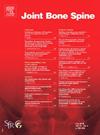Global, regional, and national burden of gout in people aged 15–39 years from 1990 to 2021: Trends, cross-country inequalities and forecast to 2035
IF 3.8
3区 医学
Q1 RHEUMATOLOGY
引用次数: 0
Abstract
Objectives
To evaluate the trends and cross-country inequalities of gout burden in people aged 15–39 years from 1990 to 2021, with projections to 2035.
Methods
The study employed estimates from Global Burden of Diseases (GBD) 2021 to assess prevalence, incidence, and years lived with disability (YLDs) of gout across global, demographic, GBD regional, national, sociodemographic index (SDI) regional, and risk factor levels. Temporal trends in the age-standardized rates (ASRs) of prevalence, incidence and YLDs were assessed by Joinpoint regression, while associations between SDI and ASRs were examined through Spearman correlation. Health inequalities were measured using the slope index of inequality and the concentration index. Future trends were forecast by a Bayesian age-period-cohort model.
Results
The burden of gout increased in global, demographic, GBD regional, and SDI level from 1990 to 2021. Males, the 35–39 years subgroup, and High-SDI regions experienced the highest burden. High-income North America owned the highest ASRs while East Asia reported the largest numbers. A moderate positive correlation was observed between gout burden and SDI for nations. Both absolute and relative inequalities increased. Males had higher YLDs due to high body mass index (BMI), females due to kidney dysfunction. Although ASRs were predicted to decrease from 2020 to 2035, numbers were predicted to rise.
Conclusions
The gout burden gout in people aged 15–39 years increased with notable inequalities. Despite projected ASRs decreases, overall numbers were likely to increase, highlighting the urgent need for targeted interventions and public health strategies.
1990年至2021年全球、区域和国家15-39岁人群痛风负担:趋势、跨国不平等和2035年预测
目的:评估1990年至2021年15-39岁人群痛风负担的趋势和跨国不平等,并预测到2035年。方法:该研究采用全球疾病负担(GBD) 2021的估计值来评估全球、人口统计学、GBD区域、国家、社会人口指数(SDI)区域和风险因素水平上痛风的患病率、发病率和残疾生活年限(YLDs)。通过关节点回归评估患病率、发病率和YLDs的年龄标准化率(ASRs)的时间趋势,通过Spearman相关检查SDI与ASRs之间的关系。采用不平等斜率指数和浓度指数测量健康不平等。未来趋势由贝叶斯年龄-时期-队列模型预测。结果:从1990年到2021年,全球、人口、GBD地区和SDI水平的痛风负担都有所增加。男性、35-39岁亚组和高sdi地区的负担最高。高收入的北美拥有最高的asr,而东亚报告的asr最多。各国痛风负担与SDI之间存在中度正相关。绝对不平等和相对不平等都增加了。男性较高的YLDs是由于高体重指数(BMI),女性较高的YLDs是由于肾功能不全。虽然预计从2020年到2035年,asr将会减少,但预计数量将会增加。结论:15 ~ 39岁人群痛风负担加重,且不平等显著。尽管预计asr会减少,但总体数字可能会增加,这突出表明迫切需要有针对性的干预措施和公共卫生战略。
本文章由计算机程序翻译,如有差异,请以英文原文为准。
求助全文
约1分钟内获得全文
求助全文
来源期刊

Joint Bone Spine
医学-风湿病学
CiteScore
4.50
自引率
11.90%
发文量
184
审稿时长
25 days
期刊介绍:
Bimonthly e-only international journal, Joint Bone Spine publishes in English original research articles and all the latest advances that deal with disorders affecting the joints, bones, and spine and, more generally, the entire field of rheumatology.
All submitted manuscripts to the journal are subjected to rigorous peer review by international experts: under no circumstances does the journal guarantee publication before the editorial board makes its final decision. (Surgical techniques and work focusing specifically on orthopedic surgery are not within the scope of the journal.)Joint Bone Spine is indexed in the main international databases and is accessible worldwide through the ScienceDirect and ClinicalKey platforms.
 求助内容:
求助内容: 应助结果提醒方式:
应助结果提醒方式:


